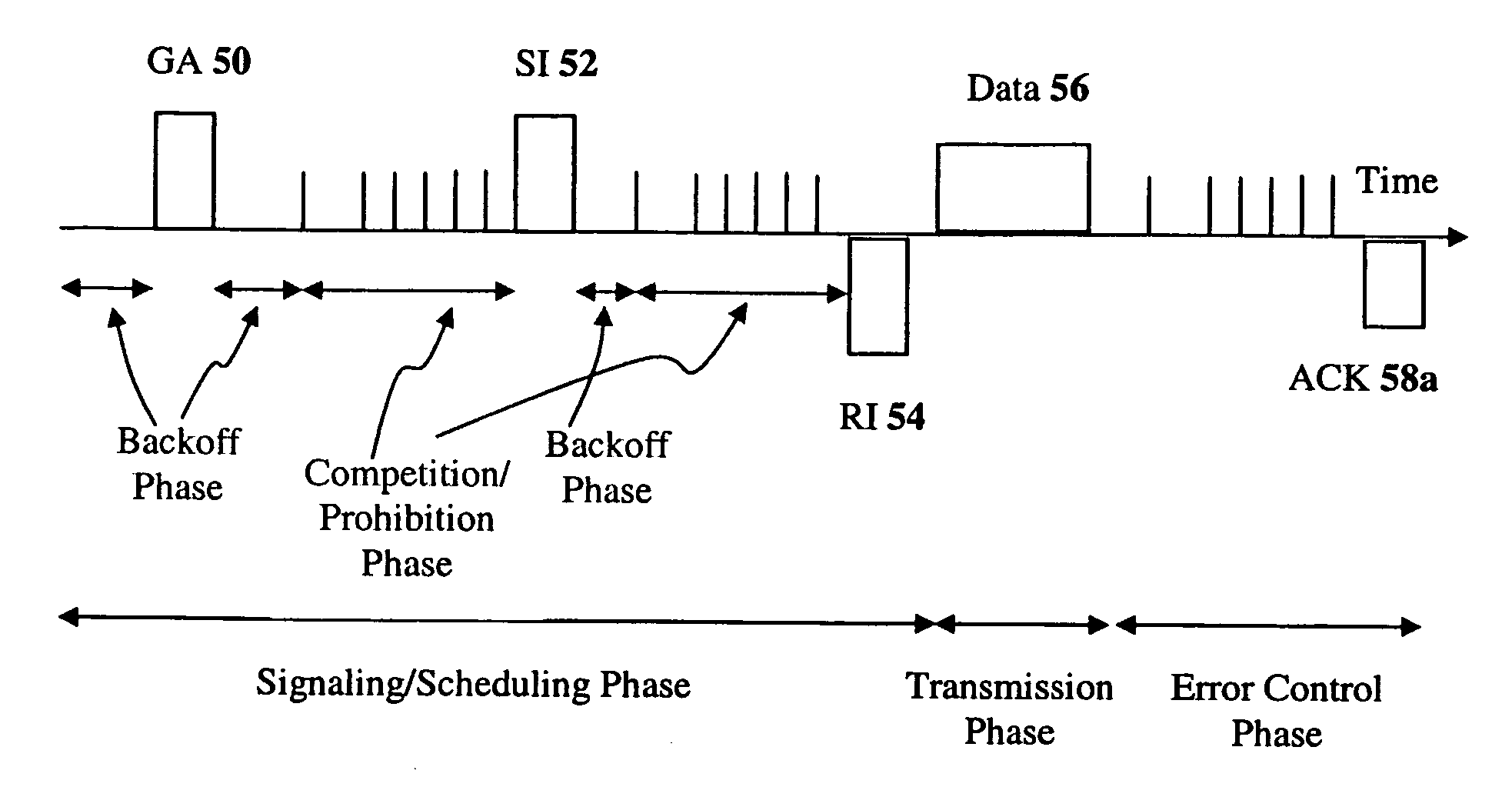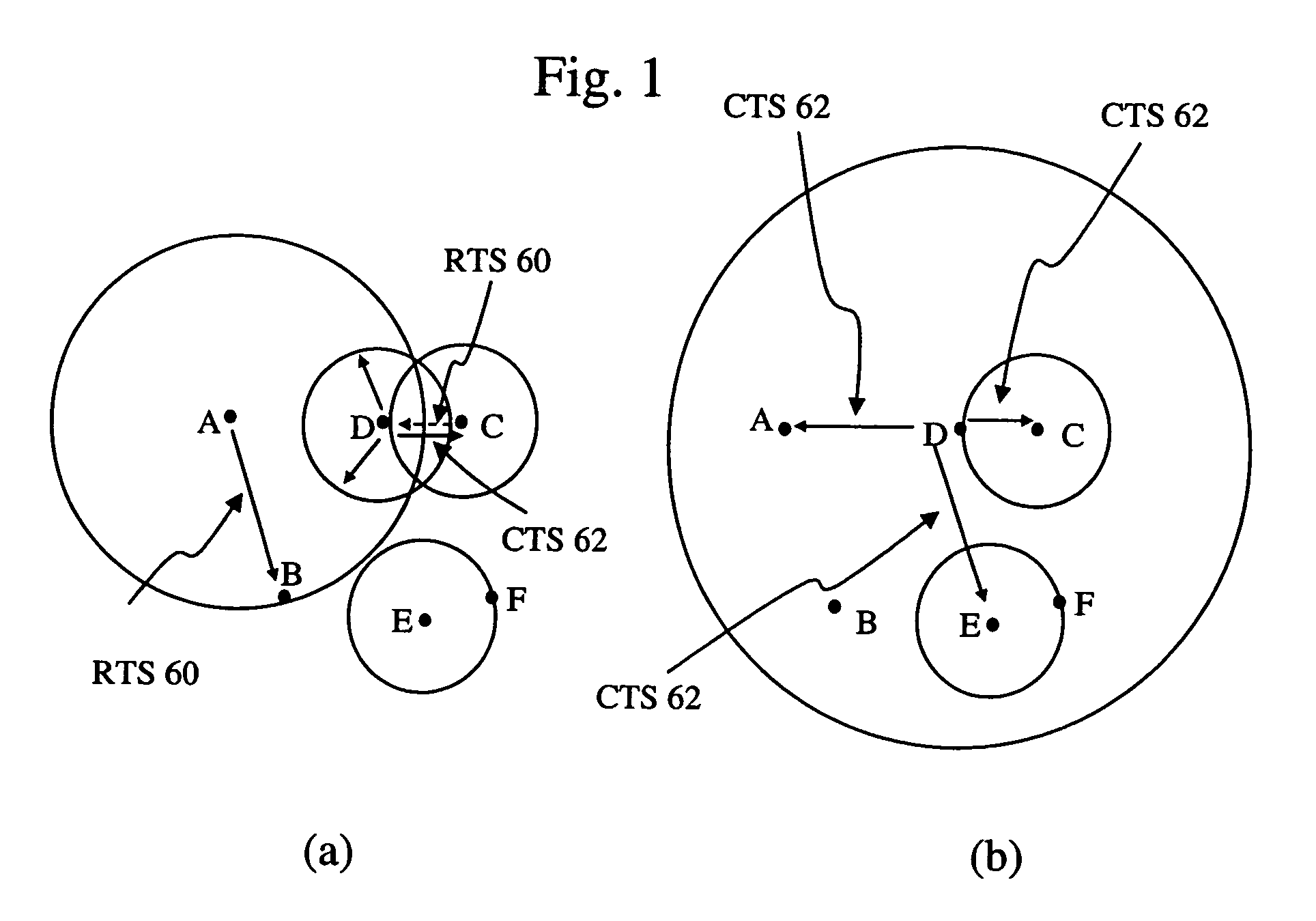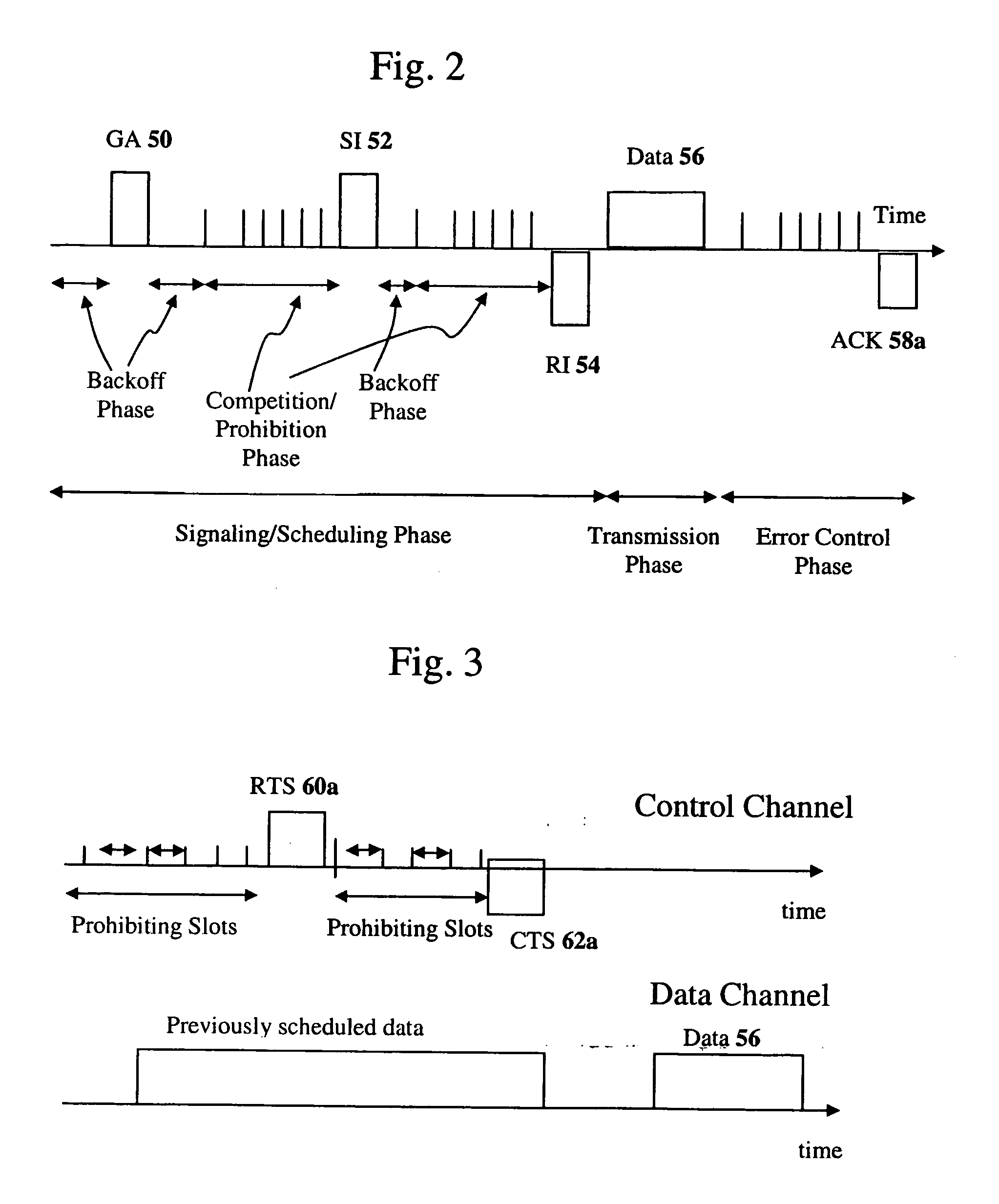When IEEE 802.11 or 802.11e is applied to ad hoc networks or multihop WLANs (i.e., WLANs extended by ad hoc relaying), several problems will be introduced.
In particular, the collision problems constitute a major issue that is inevitable in ad hoc networks and will degrade the
throughput and QoS capability of multihop networks if they are not carefully handled.
The first implication is that QoS cannot be guaranteed since packets with reservations may still be collided with
high probability during the reserved slots.
The second implication is that the contention window (CW) will be increased exponentially for unlock nodes that experience a number of collisions, which in turns leads to unbounded delays and lower
throughput for the nodes.
As a result, the
collision problem also has significant implication to fairness in such multihop wireless networks since nodes that experience a number of collisions will be treated unfairly.
The interference problems constitute a major reason for collision rates in multihop networks to be high.
When there are multiple interfering sources, the additive interference will cause collisions at even larger distance.
This, however, will introduce a new form of the exposed terminal problem in ad hoc networks.
Moreover, a new form of the hidden terminal problem will exist when there are obstructions blocking the signals from senders so that CSMA with sensitive carrier sensing hardware does not work well in multihop networks.
These problems (called the interference-range hidden / exposed terminal problem and the additive
interference problem considerably reduce the radio efficiency in ad hoc networks and multihop WLANs when IEEE 802.11 or 802.11e is employed.
The second major issue is that the energy and spatial reuse efficiency of IEEE 802.11 or 802.11e can be considerably increased when
power control and appropriate MAC mechanisms are employed.
For example, if RTS / CTS messages are transmitted at power levels as low as those for data packets, the
collision rate will be high since a new form of the hidden terminal problem will result.
As a result,
power control is not well supported in ad hoc networks due to the heterogeneous hidden / exposed terminal problem.
The third issue is the well known exposed terminal problem, when IEEE 802.11 / 11e is used in ad hoc networks and multihop WLANs.
The fourth major issue is that IEEE 802.11e is not effective in terms of differentiating discarding ratios,
delay, and throughput among different priority classes, and the delays of high-priority packets are not bounded under
heavy load.
With a nonnegligible probability, such a situation can go on for a long time when the traffic is heavy and the network is dense.
As a result, high-priority packets may still experience unacceptable
delay.
If the hardware for carrier sensing is made very sensitive so that a low-
power transmission can be detected by wireless stations at moderate distance to mitigate or solve the aforementioned heterogeneous hidden terminal problem, then the exposed terminal problem will deteriorate considerably.
All these wireless stations will then be blocked from transmissions unnecessarily, significantly reducing the network throughput in multihop wireless networking environments.
Clearly, CSMA alone cannot solve both the hidden and exposed parts of the heterogeneous terminal problem simultaneously, even when arbitrarily larger / smaller sensing range (relative to the transmission / interference ranges / areas) is available.
However, IEEE 802.11 or CSMA / CA cannot solve both the hidden and exposed parts of the heterogeneous terminal problem simultaneously either.
Since these outside wireless stations do not receive CTS 62 from the on-going
receiver, they will interfere with its reception if they decide to transmit data 56 packets with larger transmission radii.
As argued and simulated, none of these protocols can increase network throughput relative to the standard CSMA /
CA protocol of IEEE 802.11.
Although the error rates and
resultant retransmissions can be reduced, the improvement in throughput is still limited.
However, they all suffer from the “exposed part” of the heterogeneous hidden / exposed terminal problem since such CTS 62 messages block all nearby intended transmissions unnecessarily, even when these nearby intended transmitters have very small transmission / interference radii and will not collide the receptions at the senders of those CTS 62 messages.
However, this is not the case for ad hoc networks and multihop wireless LANs.
However, such an assumption does not hold in many ad hoc networking environments when IEEE 802.11 technologies are used.
Note that IEEE 802.11 / 11e does not have an efficient mechanism to
handle the IHET problem in ad hoc networks and wireless LANs.
However, the exposed terminal part of IHET will deteriorate in that many nearby nodes (especially those near the
transmitter's side) will be blocked unnecessarily.
As a result, no matter whether we assume IEEE 802.11e nodes have very sensitive hardware for CSMA, or has smaller sensing range so that frequent collisions will result from IHET, the performance of IEEE 802.11 / 11e will be considerably degraded in ad hoc networks and multihop wireless LANs.
However, their own simulations results show that the proposed modification actually reduces network throughput due to the increased overhead in relaying CTS 62 messages, even when an enhanced version with precise GPS information is used.
Although some ideas proposed are novel and interesting and PCMA can be classified as a power-controlled variable-
radius MAC protocol, a main drawback of this protocol is that each device requires two transceivers.
Moreover, the aforementioned capability required by PCMA-based mobile devices may be expensive, if not impossible, to implement.
Although these mechanisms can differentiate the delays between different traffic classes to a certain degree in single-hop wireless LANs, they are not adequate in a multihop environment such as ad hoc networks and multihop wireless LANs.
The reason is that in a single-hop
wireless LAN, an 802.11e node with higher priority is guaranteed to capture the channel before lower-priority nodes due to the fact that all nodes with
lower priority have to sense the channel for a larger
idle time (i.e., a larger IFS) and will lose the competition.
However, this is not guaranteed in ad hoc networks or multihop wireless LANs.
So high-priority nodes may still experience large
delay in IEEE 802.11e due to nearby low-priority nodes.
However, in ad hoc networks, mesh networks, multihop WLANs, and single-hop WLANs with competing APs, the collision rates tend to be higher than conventional single-hope WLANs when some unique issues in multihop networking are not appropriately addressed.
Such collision problems constitute a major issue in multihop networks, and may considerably degrade the network throughput, QoS capability, and fairness.
In particular, the delays for a traffic category of a node may increase exponentially if a couple of packets from that node experience a number of collisions and are eventually dropped.
Also, QoS cannot be guaranteed in multihop networks if the
collision rate is not sufficiently low or under control.
As a result, most previous MAC protocols cannot always provide small / bounded delay and QoS guarantees in a multihop wireless environment.
Also, several important issues such as interference and power control have not been addressed in DBTMA.
However, the prohibitive range for previous MACP protocols may be large, and may require
higher power for transmission.
Previous MACP protocols using single prohibition (without RTS / CTS dialogues), such as CSMA / IC, may not support power control well or as effectively / efficiently.
Previous MACP protocols using single prohibition (without RTS / CTS dialogues), such as CSMA / IC, may suffer from the exposed terminal problem.
The RTS and CTS messages of previous RTS / CTS-based protocols may not reach nodes within the interference / protection ranges due to maximum power limitation, unless special mechanisms are employed.
The RTS and CTS messages of previous RTS / CTS-based protocols may suffer from collisions, which in turns lead to collisions of data packets.
Previous MACP protocols using single prohibition (without RTS / CTS dialogues) may not use the prohibiting signals to as effectively and / or efficiently replace RTS and CTS messages as in some additional embodiments in this CIP document.
The latter may require prohibitively high power levels for transmissions or high sensibility for the sensing hardware when the pass loss is high.
 Login to View More
Login to View More  Login to View More
Login to View More 


